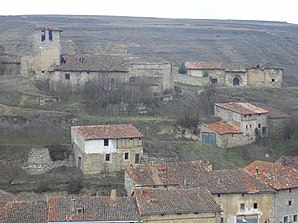Carrias
| Carrias municipality | ||
|---|---|---|
 Carrias - town view
|
||
| coat of arms | Map of Spain | |

|
|
|
| Basic data | ||
| Autonomous Community : |
|
|
| Province : | Burgos | |
| Comarca : | La Bureba | |
| Coordinates | 42 ° 35 ′ N , 3 ° 30 ′ W | |
| Height : | 845 msnm | |
| Area : | 13.26 km² | |
| Residents : | 26 (Jan. 1, 2019) | |
| Population density : | 1.96 inhabitants / km² | |
| Postal code : | 09248 | |
| Municipality number ( INE ): | 09076 | |
| administration | ||
| Website : | Carrias | |
Carrias is a northern Spanish town and a rural municipality ( municipio ) with only 26 inhabitants (as of January 1, 2019) in the province of Burgos in the autonomous community of Castile-León . The municipality belongs to the poorly populated Serranía Celtibérica .
Location and climate
The place Carrias is located in the north of the La Bureba region at an altitude of about 845 m . The provincial capital Burgos is a good 50 km (driving distance) to the southwest; Briviesca , the main town in the region, is about 10 km south. The climate in winter is harsh, but in summer it is temperate and warm; the rain, which is abundant by Spanish standards (approx. 660 mm / year), falls mainly in the winter months.
Population development
| year | 1857 | 1900 | 1950 | 2000 | 2017 |
| Residents | 309 | 220 | 172 | 50 | 25th |
The mechanization of agriculture and the closure of smaller farms have led to a loss of jobs and thus to a migration of people to the larger cities ( rural exodus ) since the middle of the 20th century . The place is almost deserted (despoblado) .
economy
For centuries, the inhabitants of the community lived mainly from agriculture (agriculture, viticulture and small livestock farming) as a self-sufficient living ; only since the middle of the 20th century has it been produced for the national market. Tourism in the form of rental of holiday homes (casas rurales) has also played a certain role in the municipality's income since the 1960s.
history
The landscape of the Bureba was already known to the people of the Stone Age and ancient times as a much-used connecting route; Celts from the tribe of the Autrigones settled here and the Romans called their later settlement near the present-day Monasterio de Rodilla Tritium Autrigonum . In the 8th and early 9th centuries, the area was under Islamic influence, but the area was neither permanently settled nor defended by the Berbers due to the unusually harsh and rainy climate . At the end of the 9th century, the Castilian Count Diego Rodríguez Porcelos received from King Alfons III. of Asturias the order to repopulate ( repoblación ) the depopulated area. The place name is first mentioned in a document from the monastery of San Millán de la Cogolla from 1007.
Attractions
- Many of the town's buildings are made of half-timbered and adobe parts .
- The Iglesia de San Saturnino , built in the 16th century, is in an extremely poor structural condition. Most of the vault segments have collapsed, others still show their star shapes. All altar retables (retablos) were brought to the Museo del Retablo in Burgos.
- The same applies to the neighboring Romanesque Ermita de Santa María del Campo .
- In the 1960s, a modern church was built in the valley near the Quintanilleja river.
Web links
- Carrias - photos + info (wikiburgos, spanish)
Individual evidence
- ↑ Cifras oficiales de población resultantes de la revisión del Padrón municipal a 1 de enero . Population statistics from the Instituto Nacional de Estadística (population update).
- ↑ Carrias - climate tables
- ^ Carrias - population development
- ↑ Carrias - History
- ↑ Carrias - churches etc.
